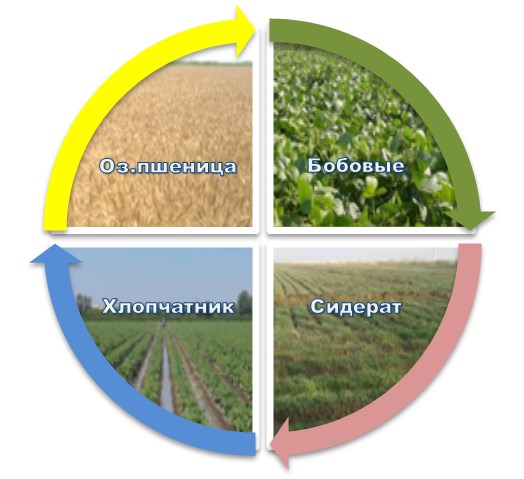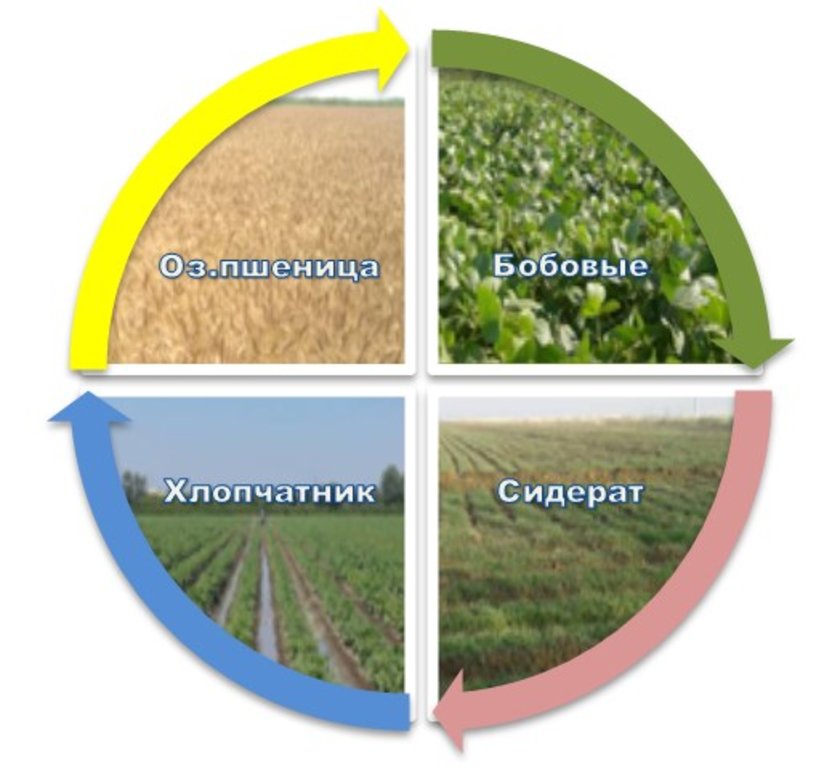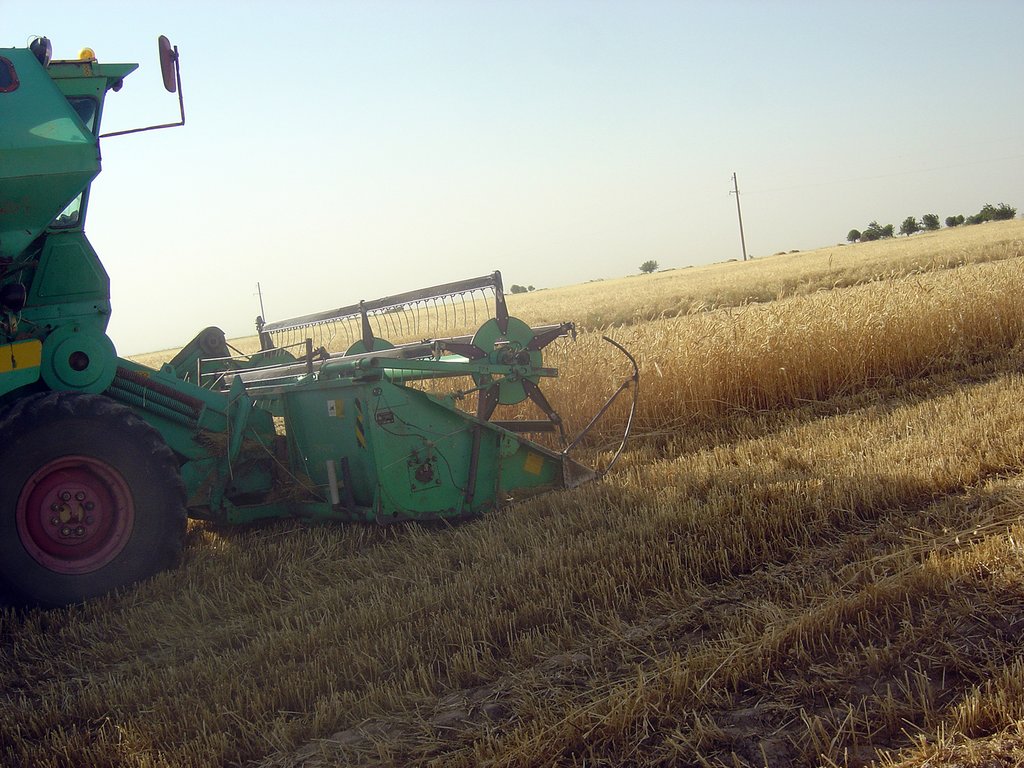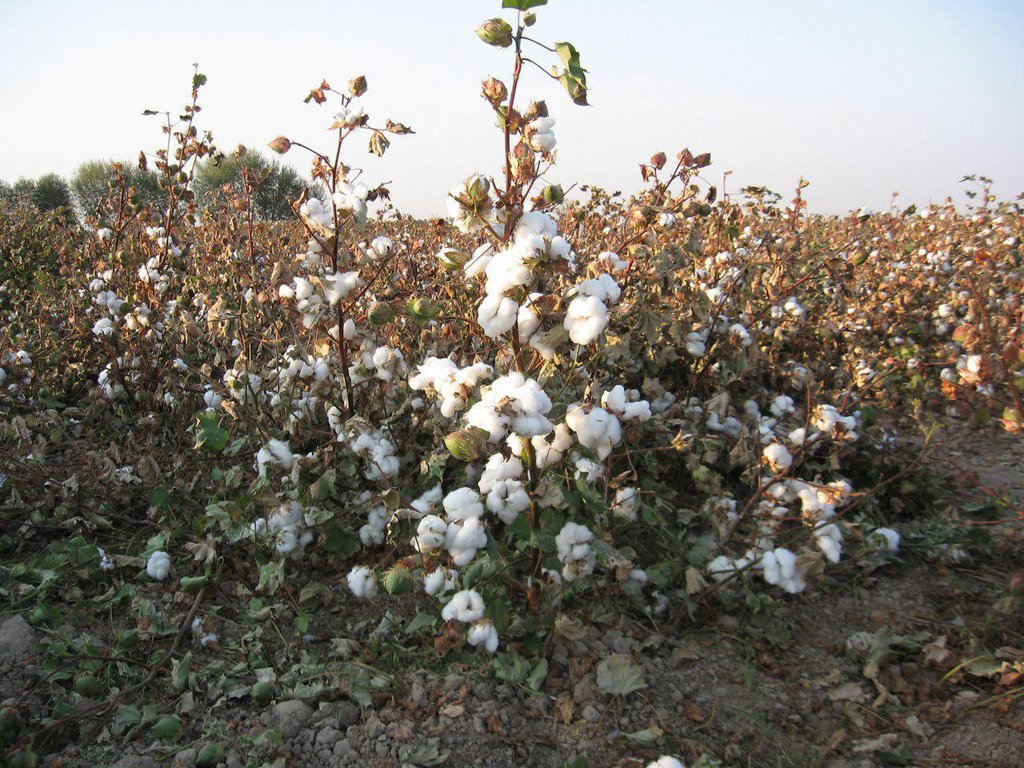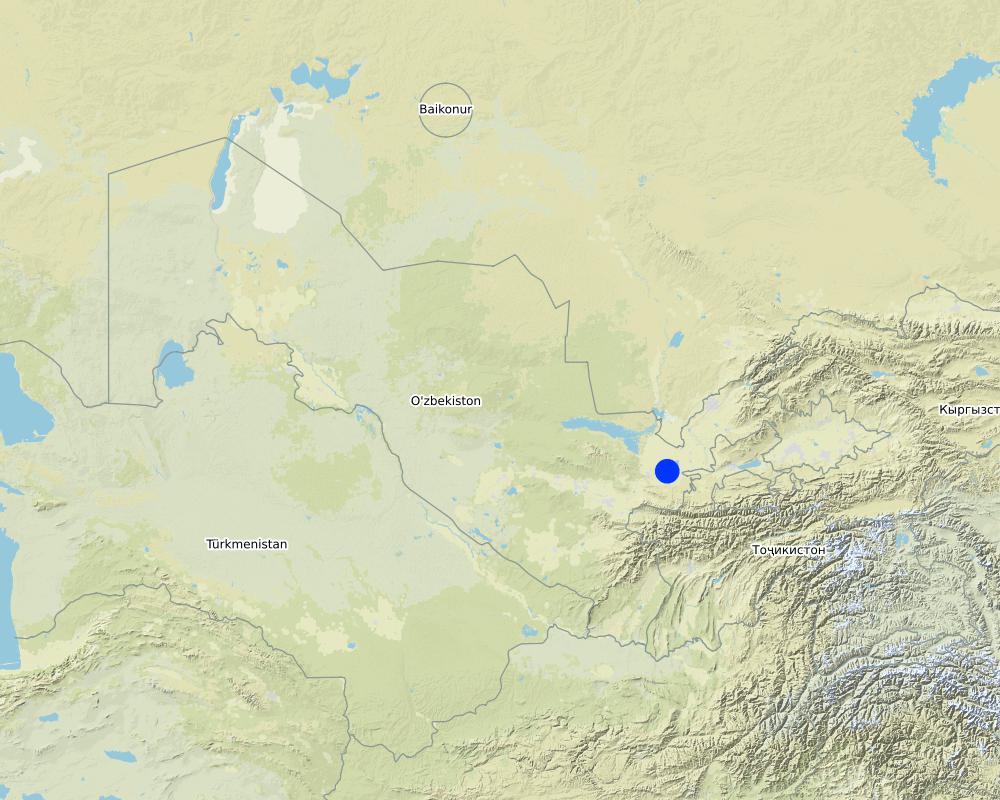Diversification of crops in salinized soils with the introduction of legumes and green manure [Uzbekistan]
- Creation:
- Update:
- Compiler: Rustam Ibragimov
- Editor: –
- Reviewers: Olga Andreeva, Elizaveta Soloveyva, Alexandra Gavilano
Diversification of crops in salinized soils with the introduction of legumes and green manure
technologies_3632 - Uzbekistan
- Full summary as PDF
- Full summary as PDF for print
- Full summary in the browser
- Full summary (unformatted)
- Диверсификация культур на подверженных засолению почвах с внедрением бобовых и сидератов: Aug. 24, 2018 (inactive)
- Диверсификация культур на подверженных засолению почвах с внедрением бобовых и сидератов: March 18, 2019 (inactive)
- Диверсификация культур на подверженных засолению почвах с внедрением бобовых и сидератов: Aug. 22, 2019 (inactive)
- Diversification of crops in salinized soils with the introduction of legumes and green manure: Jan. 21, 2020 (public)
View sections
Expand all Collapse all1. General information
1.2 Contact details of resource persons and institutions involved in the assessment and documentation of the Technology
Key resource person(s)
SLM specialist:
Khamzin Salih
UZGIP
Uzbekistan
land user:
Umirov Azim
farm "Mirishkor Azim", Keris
Uzbekistan
Name of project which facilitated the documentation/ evaluation of the Technology (if relevant)
Decision Support for Mainstreaming and Scaling out Sustainable Land Management (GEF-FAO / DS-SLM)Name of the institution(s) which facilitated the documentation/ evaluation of the Technology (if relevant)
Design and Research UZGIP Institute, Ministry of Water Resources (UzGIP) - Uzbekistan1.3 Conditions regarding the use of data documented through WOCAT
The compiler and key resource person(s) accept the conditions regarding the use of data documented through WOCAT:
Yes
1.4 Declaration on sustainability of the described Technology
Is the Technology described here problematic with regard to land degradation, so that it cannot be declared a sustainable land management technology?
No
2. Description of the SLM Technology
2.1 Short description of the Technology
Definition of the Technology:
Сrop rotation Improvement through the introduction of legumes after harvesting winter wheat and green manure crops in order to reduce land degradation and increase the productivity of irrigated lands
2.2 Detailed description of the Technology
Description:
Secondary salinization, decrease in soil organic matter and elements of mineral nutrition of plants are the main indicators of degradation of irrigated arable lands in Uzbekistan. Poor crop rotation is one of the major causes of degradation. Crop rotation “wheat-cotton-wheat” is applied On farm fields: for several years in a row cotton has been cultivated after cotton, or wheat after wheat. After harvesting of winter wheat, plant residues are removed from the fields for economic needs. The field remains fallow since June. The bare land dries up, loses its structure and resistance to soil erosion. Salts from groundwater are pulled up and accumulate in the root zone, which leads to soil salinization and production decrease. Crops diversification improves the existing crop rotation by re-sowing after winter wheat legumes and crops as a green manure/ fertilizer. The improved crop rotation includes the following steps- " winter wheat-legumes (mash, beans) - green manure (rye, etc.) - cotton»: Next, the cycle repeats. The field is under vegetation all year round, unproductive evaporation from the soil surface is reduced, which slows down the development of secondary salinization processes. Plant residues of winter wheat, legumes and green manure plants plowed into the soil replenish humus reserves. The Technology allows to get two crops (wheat and legumes) during the year, which provides land users with additional income from re-culture and contributes to strengthening the country's food security.
Costs of inputs needed for establishment:
The cultivation of repeated crops and green manure is usual, as for other row crops, therefore, local land users are well aware of the methods of preparation and tillage of the technology for growing repeated crops. The Technology does not require large additional financial and labor costs and includes chiseling, harrowing, sowing, cutting irrigation furrows, irrigation, inter-row cultivation. Growing a second crop and green manure will require financial imputs for seed acquisition, sowing and crop care. However, the income received from the re-crop crop (mung bean, beans) is about 4 million Uzbek soums / ha, and fully covers these costs
Natural and human environment:
The technology has been tested on irrigated lands in various agro-climatic zones of Uzbekistan: Kashkadarya, Jizzakh region and in South Karakalpakstan (Beruni, Turtkul and Ellikkala regions). Technology received government support. According to the Decree of the President of the country in 2018, it is planned to place repeated crops of legumes after harvesting winter wheat for 374 thousand hectares. This technology is recommended for use in farms engaged in the cultivation of cotton and winter wheat, within all irrigated areas of the country. The use of irrigation equipment and other methods of an improved surface irrigation method saves the amount of irrigation water
2.3 Photos of the Technology
2.5 Country/ region/ locations where the Technology has been applied and which are covered by this assessment
Country:
Uzbekistan
Region/ State/ Province:
Jizzakh region, Zarbdar district
Further specification of location:
village of Keriz
Specify the spread of the Technology:
- evenly spread over an area
If precise area is not known, indicate approximate area covered:
- < 0.1 km2 (10 ha)
Comments:
The Technology is evenly applied to part of the farm fields of about 5-10 ha
Map
×2.6 Date of implementation
Indicate year of implementation:
2002
If precise year is not known, indicate approximate date:
- 10-50 years ago
2.7 Introduction of the Technology
Specify how the Technology was introduced:
- through projects/ external interventions
Comments (type of project, etc.):
The Technology is being implemented through projects aimed at improving land productivity. Currently, agricultural firms are providing assistance under an agreement with the farm through district khokimiyats (local executive authorities)
3. Classification of the SLM Technology
3.1 Main purpose(s) of the Technology
- improve production
- reduce, prevent, restore land degradation
- preserve/ improve biodiversity
- create beneficial economic impact
- The main objectives are to improve soil, crop yields and food production
3.2 Current land use type(s) where the Technology is applied

Cropland
- Annual cropping
- Cotton and wheat
Number of growing seasons per year:
- 2
Specify:
It is possible to get 2 crops per year of short growing season crops (vegetables, potatoes), or when they are cultivated after harvesting winter wheat. Major crops - cotton and wheat produce 1 crop / year
3.3 Has land use changed due to the implementation of the Technology?
Has land use changed due to the implementation of the Technology?
- Yes (Please fill out the questions below with regard to the land use before implementation of the Technology)
Comments:
no change
3.4 Water supply
Water supply for the land on which the Technology is applied:
- full irrigation
3.5 SLM group to which the Technology belongs
- rotational systems (crop rotation, fallows, shifting cultivation)
- improved ground/ vegetation cover
- integrated soil fertility management
3.6 SLM measures comprising the Technology

agronomic measures
- A1: Vegetation/ soil cover
- A2: Organic matter/ soil fertility
3.7 Main types of land degradation addressed by the Technology

chemical soil deterioration
- Cn: fertility decline and reduced organic matter content (not caused by erosion)
- Cs: salinization/ alkalinization

biological degradation
- Bl: loss of soil life
Comments:
The deterioration of the soil chemical properties due to the secondary salinization is caused by natural conditions (arid climate, difficult groundwater outflow conditions) and anthropogenic impact (low efficiency of irrigation systems, inappropriate agricultural technology). Poor crop rotation (the alternation of two crops - “cotton - wheat”), low rates of organic fertilizers, harvesting of crop residues from the fields are the main reasons for the soil humus content and soil macro- and microfauna decrease.
3.8 Prevention, reduction, or restoration of land degradation
Specify the goal of the Technology with regard to land degradation:
- reduce land degradation
Comments:
Vegetation cover and plant residues reduce evaporation from the soil and prevent secondary salinization. The use of plant residues and siderate helps to increase the content of soil organic matter and nutrients, forms the structure of the soil
4. Technical specifications, implementation activities, inputs, and costs
4.1 Technical drawing of the Technology
Technical specifications (related to technical drawing):
The pattern of crop rotation is: "winter wheat - legumes (mung bean, beans) - siderat (winter rye, etc.) - cotton." As a result of the introduction of a second crop and green manure into the cotton-wheat crop rotation system, the soil surface is planted for a year
Author:
Khamzina T.
Date:
10/11/2017
4.2 General information regarding the calculation of inputs and costs
Specify how costs and inputs were calculated:
- per Technology unit
Specify unit:
ha
Specify dimensions of unit (if relevant):
1
Specify currency used for cost calculations:
- USD
If relevant, indicate exchange rate from USD to local currency (e.g. 1 USD = 79.9 Brazilian Real): 1 USD =:
3500.0
Indicate average wage cost of hired labour per day:
10 USD
4.3 Establishment activities
| Activity | Timing (season) | |
|---|---|---|
| 1. | Winter wheat growing activities | October-June |
| 2. | Bean and siderat re-cultivation activities | July-October |
| 3. | Plowing, harrowing, levelling | June |
| 4. | Sowing bean (mash) | The end of June - the beginning of July |
| 5. | Crop care (cultivation with fertilizer, watering) | July-October |
| 6. | Harvest | The end of October - the beginning of November |
| 7. | Plant residues stocking | The end of October - the beginning of November |
| 8. | Harrowing, levelling and sowing of siderates | The end of October - the beginning of November |
| 9. | Siderat stocking | April |
| 10. | Cotton Growing activities | April-October |
Comments:
The Technology allows you to get 2 crops per year - wheat and mung bean / bean, which helps to strengthen food security. Sowing legumes after harvesting winter wheat must be completed no later than July 5, otherwise repeated crops will not have time to ripen. Siderat is grown to increase soil fertility (plowed into the soil before sowing cotton), and not for harvest. As a result of continuous crop cultivation, the soil surface is covered with vegetation throughout the year, which prevents the soil from drying out, wind erosion and secondary salinization.
4.4 Costs and inputs needed for establishment
| Specify input | Unit | Quantity | Costs per Unit | Total costs per input | % of costs borne by land users | |
|---|---|---|---|---|---|---|
| Labour | Hired labor during the growing season (irrigation, crop care, harvesting) | USD/ha | 1.0 | 474.2 | 474.2 | 100.0 |
| Equipment | Use of machinery (tillage, sowing, cultivation, additional nutrition) | USD/ha | 1.0 | 584.5 | 584.5 | 100.0 |
| Plant material | Seeds (cotton, wheat, re-crop, green manure) | USD/ha | 1.0 | 233.7 | 233.7 | 54.5 |
| Fertilizers and biocides | Mineral fertilizers, manure, pesticides, defoliant | USD/ha | 1.0 | 559.6 | 559.6 | 100.0 |
| Total costs for establishment of the Technology | 1852.0 | |||||
| Total costs for establishment of the Technology in USD | 0.53 | |||||
If land user bore less than 100% of costs, indicate who covered the remaining costs:
The cost of the seeds of the re-culture (mash) and green manure (winter rye) paid by the project
4.5 Maintenance/ recurrent activities
| Activity | Timing/ frequency | |
|---|---|---|
| 1. | Winter wheat growing activities | October-June |
| 2. | Bean and siderat re-cultivation activities | July-October |
| 3. | Plowing, harrowing, levelling | June |
| 4. | Sowing bean (mash) | The end of June - the beginning of July |
| 5. | Crop care (cultivation with fertilizer, watering) | July-October |
| 6. | Harvest | The end of October - the beginning of November |
| 7. | Plant residues stocking | The end of October - the beginning of November |
| 8. | Harrowing, levelling and sowing of siderates | The end of October - the beginning of November |
| 9. | Siderat stocking | April |
| 10. | Cotton Growing activities | April-October |
Comments:
Activities to maintain technology are no different from activities to launch Technology
4.6 Costs and inputs needed for maintenance/ recurrent activities (per year)
| Specify input | Unit | Quantity | Costs per Unit | Total costs per input | % of costs borne by land users | |
|---|---|---|---|---|---|---|
| Labour | Hired labor during the growing season (irrigation, crop care, harvesting) | USD/ha | 1.0 | 474.2 | 474.2 | 100.0 |
| Equipment | Use of machinery (tillage, sowing, cultivation, additional nutrition) | USD/ha | 1.0 | 584.5 | 584.5 | 100.0 |
| Plant material | Seeds (cotton, wheat, re-crop, green manure) | USD/ha | 1.0 | 233.7 | 233.7 | 54.5 |
| Fertilizers and biocides | Mineral fertilizers, manure, pesticides, defoliant | USD/ha | 1.0 | 559.6 | 559.6 | 100.0 |
| Total costs for maintenance of the Technology | 1852.0 | |||||
| Total costs for maintenance of the Technology in USD | 0.53 | |||||
If you are unable to break down the costs in the table above, give an estimation of the total costs of maintaining the Technology:
2846.92
If land user bore less than 100% of costs, indicate who covered the remaining costs:
cost of seeds of re-culture and green manure paid by the Project
4.7 Most important factors affecting the costs
Describe the most determinate factors affecting the costs:
The highest costs relate to the use of machinery, including fuel and mineral fertilizers
5. Natural and human environment
5.1 Climate
Annual rainfall
- < 250 mm
- 251-500 mm
- 501-750 mm
- 751-1,000 mm
- 1,001-1,500 mm
- 1,501-2,000 mm
- 2,001-3,000 mm
- 3,001-4,000 mm
- > 4,000 mm
Specify average annual rainfall (if known), in mm:
418.00
Specifications/ comments on rainfall:
90% of the precipitation falls in October-May
Indicate the name of the reference meteorological station considered:
Jizzak
Agro-climatic zone
- semi-arid
The duration of the growing season is 160 days
5.2 Topography
Slopes on average:
- flat (0-2%)
- gentle (3-5%)
- moderate (6-10%)
- rolling (11-15%)
- hilly (16-30%)
- steep (31-60%)
- very steep (>60%)
Landforms:
- plateau/plains
- ridges
- mountain slopes
- hill slopes
- footslopes
- valley floors
Altitudinal zone:
- 0-100 m a.s.l.
- 101-500 m a.s.l.
- 501-1,000 m a.s.l.
- 1,001-1,500 m a.s.l.
- 1,501-2,000 m a.s.l.
- 2,001-2,500 m a.s.l.
- 2,501-3,000 m a.s.l.
- 3,001-4,000 m a.s.l.
- > 4,000 m a.s.l.
Indicate if the Technology is specifically applied in:
- not relevant
Comments and further specifications on topography:
380 m above sea level
5.3 Soils
Soil depth on average:
- very shallow (0-20 cm)
- shallow (21-50 cm)
- moderately deep (51-80 cm)
- deep (81-120 cm)
- very deep (> 120 cm)
Soil texture (topsoil):
- medium (loamy, silty)
Soil texture (> 20 cm below surface):
- medium (loamy, silty)
Topsoil organic matter:
- low (<1%)
If available, attach full soil description or specify the available information, e.g. soil type, soil PH/ acidity, Cation Exchange Capacity, nitrogen, salinity etc.
Meadow soils, humus content in the arable layer is 0.77%, the content of mobile forms of nitrogen, phosphorus, potassium-N 7,2 P 9,4 K 160
5.4 Water availability and quality
Ground water table:
< 5 m
Availability of surface water:
good
Water quality (untreated):
good drinking water
Is water salinity a problem?
Yes
Specify:
Water suitable for irrigation
Is flooding of the area occurring?
No
Comments and further specifications on water quality and quantity:
Water in surface sources is polluted from discharges of drainage from irrigation fields
5.5 Biodiversity
Species diversity:
- medium
Habitat diversity:
- medium
Comments and further specifications on biodiversity:
the vegetation is represented by cultural plant species: cotton, wheat, vegetables, melons, perennial plantations, fruit and ornamental trees and shrubs
5.6 Characteristics of land users applying the Technology
Sedentary or nomadic:
- Sedentary
Market orientation of production system:
- mixed (subsistence/ commercial)
Off-farm income:
- > 50% of all income
Relative level of wealth:
- average
Individuals or groups:
- individual/ household
Level of mechanization:
- mechanized/ motorized
Gender:
- men
Age of land users:
- middle-aged
5.7 Average area of land used by land users applying the Technology
- < 0.5 ha
- 0.5-1 ha
- 1-2 ha
- 2-5 ha
- 5-15 ha
- 15-50 ha
- 50-100 ha
- 100-500 ha
- 500-1,000 ha
- 1,000-10,000 ha
- > 10,000 ha
Is this considered small-, medium- or large-scale (referring to local context)?
- medium-scale
Comments:
The average size of farms is 35-75 hectares, dekhkan and household plots - up to 0.35 hectares
5.8 Land ownership, land use rights, and water use rights
Land ownership:
- state
Land use rights:
- leased
Water use rights:
- open access (unorganized)
5.9 Access to services and infrastructure
health:
- poor
- moderate
- good
education:
- poor
- moderate
- good
technical assistance:
- poor
- moderate
- good
employment (e.g. off-farm):
- poor
- moderate
- good
markets:
- poor
- moderate
- good
energy:
- poor
- moderate
- good
roads and transport:
- poor
- moderate
- good
drinking water and sanitation:
- poor
- moderate
- good
financial services:
- poor
- moderate
- good
6. Impacts and concluding statements
6.1 On-site impacts the Technology has shown
Socio-economic impacts
Production
crop production
Quantity before SLM:
1.62 tons / ha
Quantity after SLM:
3.18 tons / ha
Comments/ specify:
cotton yields doubled after applying crop diversification system
Income and costs
expenses on agricultural inputs
farm income
Comments/ specify:
Increase in income by 500 USD/ ha
workload
Socio-cultural impacts
food security/ self-sufficiency
Ecological impacts
Soil
nutrient cycling/ recharge
Comments/ specify:
The assessment was carried out in the second year after the Technology implementation
salinity
Comments/ specify:
The assessment was carried out in the second year after the Technology implementation
soil organic matter/ below ground C
Comments/ specify:
The assessment was carried out in the second year after the Technology implementation
Biodiversity: vegetation, animals
Vegetation cover
plant diversity
Quantity before SLM:
2 crops (wheat, cotton)
Quantity after SLM:
4 crops (wheat, cotton, mung bean, winter rye)
Comments/ specify:
Additional cultivation of two crops (mung bean, winter rye again after winter wheat)
6.2 Off-site impacts the Technology has shown
Specify assessment of off-site impacts (measurements):
The Technology does not have negative off-site impacts
6.3 Exposure and sensitivity of the Technology to gradual climate change and climate-related extremes/ disasters (as perceived by land users)
Gradual climate change
Gradual climate change
| Season | increase or decrease | How does the Technology cope with it? | |
|---|---|---|---|
| seasonal temperature | winter | increase | very well |
| seasonal temperature | spring | increase | well |
| seasonal temperature | summer | increase | well |
| seasonal temperature | autumn | increase | well |
| annual rainfall | decrease | not well |
Climate-related extremes (disasters)
Meteorological disasters
| How does the Technology cope with it? | |
|---|---|
| local hailstorm | not well |
Climatological disasters
| How does the Technology cope with it? | |
|---|---|
| heatwave | not well |
| drought | not well |
Biological disasters
| How does the Technology cope with it? | |
|---|---|
| insect/ worm infestation | not well at all |
Other climate-related consequences
Other climate-related consequences
| How does the Technology cope with it? | |
|---|---|
| extended growing period | very well |
| reduced growing period | moderately |
6.4 Cost-benefit analysis
How do the benefits compare with the establishment costs (from land users’ perspective)?
Short-term returns:
positive
Long-term returns:
very positive
How do the benefits compare with the maintenance/ recurrent costs (from land users' perspective)?
Short-term returns:
positive
Long-term returns:
very positive
Comments:
The benefits are already positive in the short term
6.5 Adoption of the Technology
- 11-50%
Of all those who have adopted the Technology, how many did so spontaneously, i.e. without receiving any material incentives/ payments?
- 0-10%
6.6 Adaptation
Has the Technology been modified recently to adapt to changing conditions?
No
6.7 Strengths/ advantages/ opportunities of the Technology
| Strengths/ advantages/ opportunities in the land user’s view |
|---|
| Fast high income |
| The ability to produce food crops on the same area |
| Crop Production which is traditionally used in local culture |
| Strengths/ advantages/ opportunities in the compiler’s or other key resource person’s view |
|---|
| No special training for land users is required (only awareness raising), all activities are based on traditional knowledge |
| Quick income generation: up to 500 USD net income per hectare |
| Local resources and materials are used, no special equipment is required |
| Provides food production |
6.8 Weaknesses/ disadvantages/ risks of the Technology and ways of overcoming them
| Weaknesses/ disadvantages/ risks in the land user’s view | How can they be overcome? |
|---|---|
| Need for additional irrigation water | Water conservation |
| The risk of delays with the sowing period (until July 5) and not to get the crop | Improve the organization of field work |
| Weaknesses/ disadvantages/ risks in the compiler’s or other key resource person’s view | How can they be overcome? |
|---|---|
| Lack of broad information on the costs and inputs of Technology | Awareness raising on the costs and benefits of technology on a larger scale |
| Need for additional irrigation water | Water conservation provides sufficient water for irrigation of re-crops and siderates (about 1200 m3 / ha) |
7. References and links
7.1 Methods/ sources of information
- field visits, field surveys
July-November 2016-2017, 2013
- interviews with land users
3 persons
- interviews with SLM specialists/ experts
3 persons
- compilation from reports and other existing documentation
When were the data compiled (in the field)?
11/09/2017
7.2 References to available publications
Title, author, year, ISBN:
Practices And Technologies For Sustainable Use Of Irrigated And RainFed Lands Subject To Salinization And Drought T. Khamzina, T. Mukimov, A. Ismonov, G. Khasankhanova And U. Abdullayev, 2018, Tashkent
Available from where? Costs?
"Иклим узгариши шароитида ер ресурсларини баркарор бошкариш" в сборнике статей Республиканского научно-практического семинара
Links and modules
Expand all Collapse allLinks
No links
Modules
No modules


